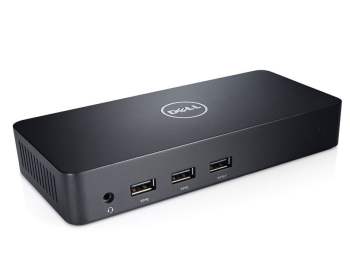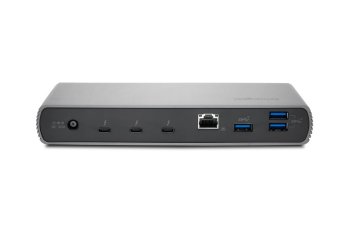- Supports multiple displays
- Small footprint
- Good range of ports
- Affordable price
- Advanced Thunderbolt 4 ports
- Supports high-resolution displays
- Extensive connectivity options
- Durable build
- Limited to one 4K display
- Plastic construction
- High cost
- Requires Thunderbolt compatibility
Dell D3100 vs Kensington SD5700T
When it comes to laptop docking stations, two popular options on the market are the Dell D3100 and the Kensington SD5700T. Both of these devices aim to provide a convenient and efficient way to connect laptops to various peripherals, such as monitors, keyboards, and mice, while also expanding their port capabilities. In this comparison, we'll delve into the features, performance, and design of each product to help you decide which one best suits your needs.
Design and Build Quality
The Dell D3100 has a compact and sleek design, measuring 8.1 inches in width, 3.5 inches in depth, and 1.2 inches in height. It's made of durable plastic and has a sturdy build that can withstand regular use. The device features a simple and intuitive layout, with all the ports located on the back and sides.
In contrast, the Kensington SD5700T has a more premium design, with a metallic finish and a slightly larger footprint (8.5 inches in width, 4.2 inches in depth, and 1.5 inches in height). The device has a more robust build quality, with a solid weight that prevents it from shifting around on your desk.
Port Expansion and Connectivity
Both laptop docking stations offer an impressive array of ports to expand your laptop's connectivity options. The Dell D3100 features:
- 2x USB-A 3.0 ports
- 1x USB-C port (with Power Delivery)
- 1x HDMI port
- 1x DisplayPort
- 1x Gigabit Ethernet port
The Kensington SD5700T, on the other hand, offers:
- 4x USB-A 3.0 ports
- 2x USB-C ports (one with Power Delivery and one with data transfer only)
- 2x HDMI ports
- 2x DisplayPort ports
- 1x Gigabit Ethernet port
As you can see, the Kensington SD5700T provides more USB ports and dual DisplayPort connections, making it a better option for users who need to connect multiple monitors or peripherals.
Performance and Compatibility
Both docking stations support up to 4K resolution at 30Hz, but the Kensington SD5700T has an advantage when it comes to graphics performance. It supports up to two 4K displays at 60Hz, while the Dell D3100 is limited to a single 4K display at 30Hz.
In terms of compatibility, both devices support Windows and macOS laptops, but the Kensington SD5700T also supports Chrome OS devices. Additionally, the SD5700T has a more comprehensive driver support system, which ensures seamless connectivity and minimizes the risk of compatibility issues.
Power Delivery and Charging
The Dell D3100 can deliver up to 65W of power to your laptop via its USB-C port, while the Kensington SD5700T can deliver up to 85W. This makes the SD5700T a better option for users with larger laptops that require more power to charge.
Conclusion
In conclusion, both the Dell D3100 and the Kensington SD5700T are excellent laptop docking stations that offer a range of features and benefits. However, the Kensington SD5700T stands out as the more premium and feature-rich option, with its robust build quality, expanded port selection, and superior graphics performance.
If you're looking for a reliable and efficient way to connect your laptop to multiple peripherals and expand its port capabilities, the Dell D3100 is still a great choice. However, if you need a more advanced docking station that can support dual 4K displays, has more USB ports, and delivers more power to your laptop, the Kensington SD5700T is the better option.
Ultimately, the decision between these two laptop docking stations will depend on your specific needs and preferences. We recommend carefully considering your requirements and weighing the pros and cons of each device before making a final decision.































